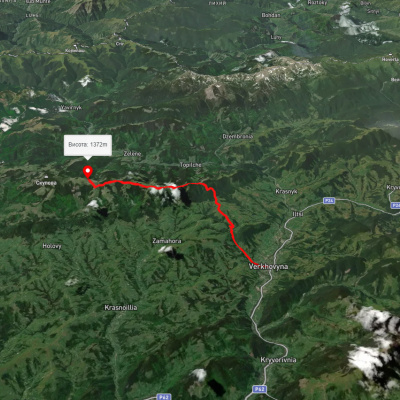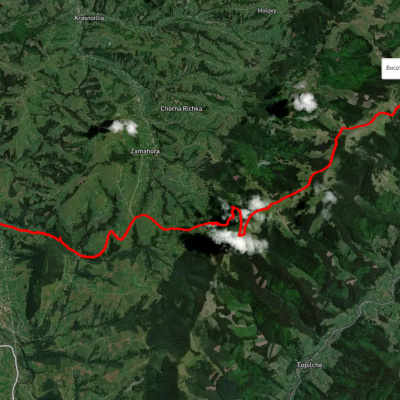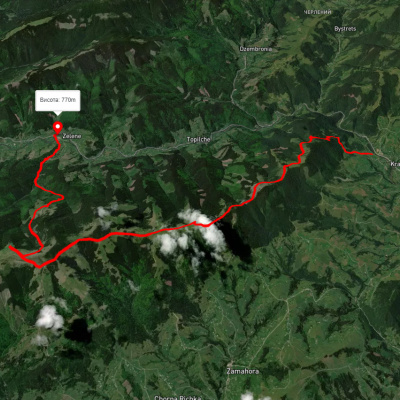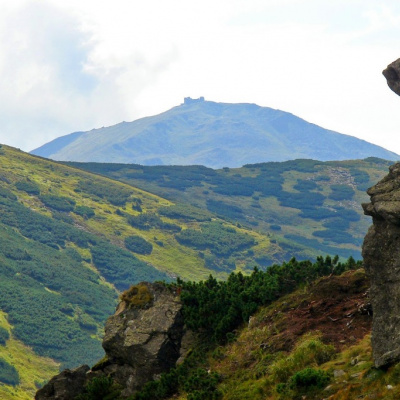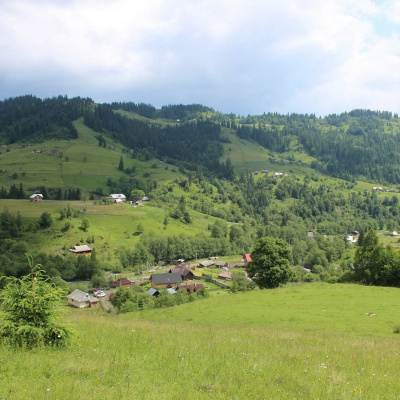Verkhovyna district
Verkhovyna district was formed in 1966. The district center is Verkhovyna (until 1962 - the village of Zhabie). The oldest settlements include the villages of Krasnoillia (old name Didushkova River), Dovhopole, Kryvorivnia. Verkhovyna district is the only administrative district of the region that is completely located on the territory of the Carpathian mountain system, within the Hutsul Carpathians (Chyvchyny, Chornohora, Hryniava). The 45 km long Chyvchyny ridge forms the state border with Romania. Tourist locations of the district include Verkhniy Yaseniv (Rivne), Vyhoda, Bukovets (Cheretiv), Bystrets, Biloberizka (Usteriki), Burkut, Volova, Holovy, Holoshyna, Iltsi, Krasnyk, Kryvopillia, Dzembronia, Zelene (Topilche), Stebni, Perekhresne, Yavirnyk.
Thevillages of Burkut, Holovy, Dovhopole, Krasnoillia, Kryvorivnia are known for the fact that Lesia Ukrainka, Ivan Franko, Olha Kobylianska, Mykhailo Kotsiubynskyi, Vasyl Stefanyk, and others rested and received treatment here. The village of Burkut used to have a balneological resort, and Burkut water was bottled in glass bottles with the relief inscription "Burkut". It is believed that the best times of Burkut resort were in the 20s of the nineteenth century under Polish rule. At that time, 18 villas were built, the resort was restored and the bottling of mineral water in glass containers was established. With the outbreak of the Second World War, Poland ceased to exist, and the resort disappeared with it. Nowadays, Burkut is called "dead" because the village has not had a single permanent resident since 2008.
Verkhovyna district borders on Putyla, Yaremche, and Rakhiv districts.
The Hutsul region made a great impression on Kotsiubynskyi, and he wrote the novel Shadows of Forgotten Ancestors, and half a century later, the brilliant director Sergei Parajanov shot his famous film of the same name here. Nowadays, there is a film museum in Verkhovyna. The Ukrainian writer Hnat Khotkevych lived in the village of Krasnoillia (1906-1912), where he wrote the novels "Stone Soul," "Dovbush," and others. It was in this village that he created the amateur Hutsul theater, known outside Ukraine. Today, the Hnat Khotkevych Museum is open here.
Due to the inaccessibility of the mountains, for many centuries the territory inhabited by the Hutsuls (an ethnic group of Ukrainian highlanders who inhabit the entire territory of the Verkhovyna district) has not been affected by civilization with its urbanized society. Many interesting customs, traditions, folklore rituals, and retellings of folk tales and legends are preserved here. To see this, it is enough to visit Verkhovyna during the Christmas holidays, Easter, the First Holy Day (the feast of the Assumption of the Blessed Virgin Mary on August 28 is a church holiday for Verkhovyna residents) or the Green Holidays (Holy Trinity).
Of particular interest to hikers is the third peak of the Ukrainian Carpathians, Mount Pip Ivan (2022m ), with the ruins of a meteorological observatory at the very top (mentioned in the novel Twelve Hoops by Yuri Andrukhovych). In one of the glacial carriages on the slopes of the mountain there is a high-mountain lake with the affectionate name of Maricheika.
There are no luxury hotels or private boarding houses in Verkhovyna district yet. One of the organizations that is most actively engaged in servicing tourists is the district branch of the Union for the Promotion of Rural Green Tourism in Ukraine. This type of tourism is mistakenly considered new in Ukraine, but the first "summerers" (as tourists were called back then) appeared in the Hutsul region in the century before last. Many of them spent their vacations in Hutsul dwellings, and in a few summer months managed to visit almost all the surrounding mountains on foot and on horseback.
The largest river is the Cheremosh, with a total basin area of 2565 km². The territory of the district consists of the Black Cheremosh basin and the left-bank part of the White Cheremosh basin. Verkhovyna is one of the richest regions in Ukraine in terms of mineral water. There are more than 100 mineral water sources here. Only in the village of Verkhovyna and the village of Burkut there are 10 studied mineral water springs.
Religious buildings
- Verkhovyna Church of the Assumption of the Blessed Virgin Mary;
- Verkhovyna Church of St. George the Victorious;
- Verkhovyna Church of the Conception of St. Anne;
- The Church of the Nativity of the Blessed Virgin Mary (1719) with a bell tower (1818), Kryvorivnia village
- St. Nicholas Church (1867), wooden; Barvinkiv village
- Church of the Assumption of St. Anna (1872), wooden; Bystrets village
- Trinity Church (1882), wooden; there is also a memorable cross near the church in honor of the abolition of serfdom and the grave of Sich Riflemen; Verkhniy Yaseniv village
- Church of the Intercession of the Blessed Virgin Mary (1849), wooden with a bell tower; Biloberizka village
- The Church of the Exaltation of the Head of John the Baptist (1872) with an iconostasis, wooden; Zelene village
- The Church of Ss. Peter and Paul (1843), wooden, with a bell tower; Krasnoillia village
- The Church of the Ascension (1938), wooden; Usteriki village
- St. Michael's Church (1872), wooden; Dovhopillia village
- St. Michael's Church (1872), wooden; Cheremoshna village
Architectural monuments
- The ruins of the observatory (1938) are located on the top of Pip Ivan (or Chornohora) at an altitude of 2028 m. The Poles called it the "White Elephant" because of the snow and ice that cover the outer walls in winter.
- The house of the Burachynski-Wolansky priestly dynasty in the village of Kryvorivnia
There are over 100 mineral water springs in the area, including many unnamed hydrogen sulfide springs. There are 10 studied springs in Verkhovyna and Burkut village. Carbon dioxide waters are distributed in the southern part of the region, within the Verkhovyna district in the Black Cheremosh basin. Their composition and properties are similar to the famous Caucasian mineral springs Narzan and Borjomi. There are wells of mineral water "Verkhovyna" (Verkhovyna village) and hydrogen sulfide water (Kryvopillia village).
The Hadzhyna and Kedrovatyi tracts are located on the northern megaslope of Chornohora. On the rocky slopes covered with spruce forests, the only relict site of European cedar pine in this massif has been preserved. Above the spruce forests, at an altitude of 1600-1850 m, a subalpine vegetation belt of mountain pine (zherepa), green alder (lelecha), and Siberian juniper is formed. Blueberry forests, alpine meadows, etc. are also common here.
- Dovbushanka Mountain with deep stone Dovbush's Barns on the top. There is also a geological natural monument of national importance, the Dovbushanka Rock Corridor.
- The Pysanyi Kamen Mountain is a huge sandstone block consisting of 2-3 m high stones that stretch in a chain for about 80 m, growing into massive monoliths up to 20 m high, the top of which forms a horizontal plane.
Natural parks of Verkhovyna district
- Verkhovynskyi National Nature Park, the territory of Holoshyn and Zelenskyi village councils;
- Carpathian National Nature Park, the territory of the Yaremche City Council and Verkhovyna district of Ivano-Frankivsk region.
Attractions and museums
- Hutsulshchyna Museum of History and Local Lore - I. Franko str;
- House-museum of the movie "Shadows of Forgotten Ancestors" on Zhabievsky Potik Street;
- Verkhovyna Museum of Musical Instruments by Roman Kumlyk;
- Verkhovyna Museum of Folk Culture "At the Trembitard", pr. Shveykovo;
- Museum of the house-citizen, where the movie "Annichka" was filmed, 56 Zhabievsky Potik;
- Museum of Hutsul Magic, Zhabievsky Potik Street;
- Museum of Embroidery, Velykyi Hrabovets village;
- Khata Staya (cheese factory), Zhabievsky Potik Street;
- Museum of Paraska Plytka-Horytsvit, Kryvorivnia village, Hreshparivka village;
- Museum of Applied Arts, Iltsi village;
- Museum of mushrooms, Iltsi village.
Individual excursions and tours to the sights, museums and mountains of Verkhovyna region
- Sightseeing tour of Verkhovyna with a visit to one of the museums and an observation tower;
- Excursion to the S. Parajanov Museum "Shadows of Forgotten Ancestors";
- Excursion to the Roman Kumlyk Museum of Musical Instruments, Verkhovyna;
- Museum of Hutsul Magic in Verkhovyna;
- Halyna Verkhovynka's private museum "Vyshyvanka", Iltsi village;
- Excursion to the Museum of Hutsul Life and Art "At the Trembitard", Verkhovyna (Shveykovo village);
- Excursion to the Mykhailo Hrushevsky Museum in Kryvorivnia;
- Excursion to the Ivan Franko Museum in Kryvorivnya;
- Excursion to the House-Citizen Museum in Kryvorivnia;
- Ethnographic Museum of Hutsul Antiquities - Yaroslav Zelenchuk's private museum, Kryvorivnia village;
- Private museum Gallery of Hutsul traditions and rituals, Verkhovyna;
- One-day hikes on the Chornohora ridge: to Mt. Vuhatyi Kamen, Rebra and Shpytsi mountains;
- One-day hikes to Pushkar, Magurka, Magura, Plai, Bila Kobyla;
- Excursion to the Krynta meadow.
Mountain Search and Rescue Service, +38 (03432) 2-19-41, +38 (067) 342-04-96.
Tourist Information Center, Verkhovyna village, 7 Mykola Rybchuk St., +38 (03432) 2-19-41, 2-19-71, +38 (096) 372-44-00, (067) 88-22-800
Які туристичні (пішохідні) маршрути проходять через/біля Verkhovyna district?
Пропонуємо пройти такі туристичні (пішохідні) маршрути через/біля Verkhovyna district: смт. Верховина – г. Скупова, смт. Верховина – хр. Кринта-Скупова, с. Красник, через хр. Кринта–Скупова до с. Зелене, с. Красник, через г. Кринта, г. Зміїнська, с. Шибене, пол. Веснарка, оз. Марічейка до с. Дземброня, с. Зелене, через г. Скупова до смт. Верховина, Зелене - Скупова
